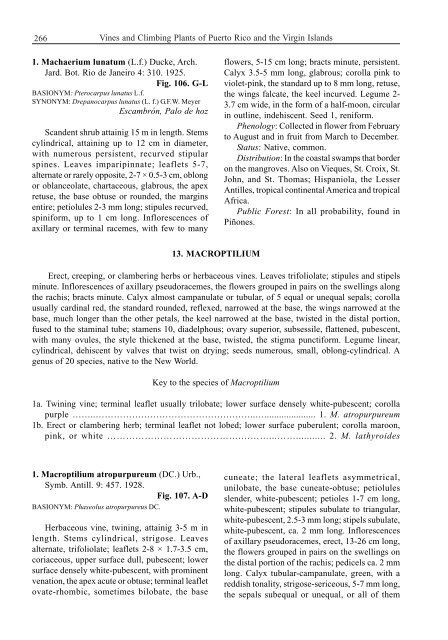Vines and Climbing Plants of Puerto Rico and the Virgin Islands
Vines and Climbing Plants of Puerto Rico and the Virgin Islands
Vines and Climbing Plants of Puerto Rico and the Virgin Islands
Create successful ePaper yourself
Turn your PDF publications into a flip-book with our unique Google optimized e-Paper software.
266<br />
<strong>Vines</strong> <strong>and</strong> <strong>Climbing</strong> <strong>Plants</strong> <strong>of</strong> <strong>Puerto</strong> <strong>Rico</strong> <strong>and</strong> <strong>the</strong> <strong>Virgin</strong> Isl<strong>and</strong>s<br />
1. Machaerium lunatum (L.f.) Ducke, Arch.<br />
Jard. Bot. Rio de Janeiro 4: 310. 1925.<br />
Fig. 106. G-L<br />
BASIONYM: Pterocarpus lunatus L.f.<br />
SYNONYM: Drepanocarpus lunatus (L. f.) G.F.W. Meyer<br />
Escambrón, Palo de hoz<br />
Sc<strong>and</strong>ent shrub attainig 15 m in length. Stems<br />
cylindrical, attaining up to 12 cm in diameter,<br />
with numerous persistent, recurved stipular<br />
spines. Leaves imparipinnate; leaflets 5-7,<br />
alternate or rarely opposite, 2-7 × 0.5-3 cm, oblong<br />
or oblanceolate, chartaceous, glabrous, <strong>the</strong> apex<br />
retuse, <strong>the</strong> base obtuse or rounded, <strong>the</strong> margins<br />
entire; petiolules 2-3 mm long; stipules recurved,<br />
spiniform, up to 1 cm long. Inflorescences <strong>of</strong><br />
axillary or terminal racemes, with few to many<br />
13. MACROPTILIUM<br />
flowers, 5-15 cm long; bracts minute, persistent.<br />
Calyx 3.5-5 mm long, glabrous; corolla pink to<br />
violet-pink, <strong>the</strong> st<strong>and</strong>ard up to 8 mm long, retuse,<br />
<strong>the</strong> wings falcate, <strong>the</strong> keel incurved. Legume 2-<br />
3.7 cm wide, in <strong>the</strong> form <strong>of</strong> a half-moon, circular<br />
in outline, indehiscent. Seed 1, reniform.<br />
Phenology: Collected in flower from February<br />
to August <strong>and</strong> in fruit from March to December.<br />
Status: Native, common.<br />
Distribution: In <strong>the</strong> coastal swamps that border<br />
on <strong>the</strong> mangroves. Also on Vieques, St. Croix, St.<br />
John, <strong>and</strong> St. Thomas; Hispaniola, <strong>the</strong> Lesser<br />
Antilles, tropical continental America <strong>and</strong> tropical<br />
Africa.<br />
Public Forest: In all probability, found in<br />
Piñones.<br />
Erect, creeping, or clambering herbs or herbaceous vines. Leaves trifoliolate; stipules <strong>and</strong> stipels<br />
minute. Inflorescences <strong>of</strong> axillary pseudoracemes, <strong>the</strong> flowers grouped in pairs on <strong>the</strong> swellings along<br />
<strong>the</strong> rachis; bracts minute. Calyx almost campanulate or tubular, <strong>of</strong> 5 equal or unequal sepals; corolla<br />
usually cardinal red, <strong>the</strong> st<strong>and</strong>ard rounded, reflexed, narrowed at <strong>the</strong> base, <strong>the</strong> wings narrowed at <strong>the</strong><br />
base, much longer than <strong>the</strong> o<strong>the</strong>r petals, <strong>the</strong> keel narrowed at <strong>the</strong> base, twisted in <strong>the</strong> distal portion,<br />
fused to <strong>the</strong> staminal tube; stamens 10, diadelphous; ovary superior, subsessile, flattened, pubescent,<br />
with many ovules, <strong>the</strong> style thickened at <strong>the</strong> base, twisted, <strong>the</strong> stigma punctiform. Legume linear,<br />
cylindrical, dehiscent by valves that twist on drying; seeds numerous, small, oblong-cylindrical. A<br />
genus <strong>of</strong> 20 species, native to <strong>the</strong> New World.<br />
Key to <strong>the</strong> species <strong>of</strong> Macroptilium<br />
1a. Twining vine; terminal leaflet usually trilobate; lower surface densely white-pubescent; corolla<br />
purple ……..……………………………………………..…..................... 1. M. atropurpureum<br />
1b. Erect or clambering herb; terminal leaflet not lobed; lower surface puberulent; corolla maroon,<br />
pink, or white …………………………………….………...……........... 2. M. lathyroides<br />
1. Macroptilium atropurpureum (DC.) Urb.,<br />
Symb. Antill. 9: 457. 1928.<br />
Fig. 107. A-D<br />
BASIONYM: Phaseolus atropurpureus DC.<br />
Herbaceous vine, twining, attainig 3-5 m in<br />
length. Stems cylindrical, strigose. Leaves<br />
alternate, trifoliolate; leaflets 2-8 × 1.7-3.5 cm,<br />
coriaceous, upper surface dull, pubescent; lower<br />
surface densely white-pubescent, with prominent<br />
venation, <strong>the</strong> apex acute or obtuse; terminal leaflet<br />
ovate-rhombic, sometimes bilobate, <strong>the</strong> base<br />
cuneate; <strong>the</strong> lateral leaflets asymmetrical,<br />
unilobate, <strong>the</strong> base cuneate-obtuse; petiolules<br />
slender, white-pubescent; petioles 1-7 cm long,<br />
white-pubescent; stipules subulate to triangular,<br />
white-pubescent, 2.5-3 mm long; stipels subulate,<br />
white-pubescent, ca. 2 mm long. Inflorescences<br />
<strong>of</strong> axillary pseudoracemes, erect, 13-26 cm long,<br />
<strong>the</strong> flowers grouped in pairs on <strong>the</strong> swellings on<br />
<strong>the</strong> distal portion <strong>of</strong> <strong>the</strong> rachis; pedicels ca. 2 mm<br />
long. Calyx tubular-campanulate, green, with a<br />
reddish tonality, strigose-sericeous, 5-7 mm long,<br />
<strong>the</strong> sepals subequal or unequal, or all <strong>of</strong> <strong>the</strong>m
















